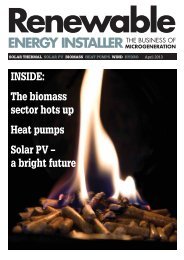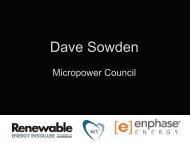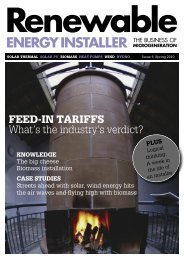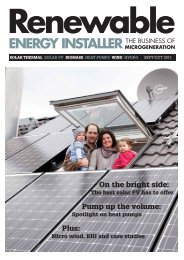REI Mar-Apr 2012 - Renewable Energy Installer
REI Mar-Apr 2012 - Renewable Energy Installer
REI Mar-Apr 2012 - Renewable Energy Installer
Create successful ePaper yourself
Turn your PDF publications into a flip-book with our unique Google optimized e-Paper software.
Knowledge: Solar PV<br />
Big is beautiful<br />
Cumbria’s largest commercial solar PV system at Lakeland Livestock <strong>Mar</strong>t,<br />
Cockermouth, benefits from new technology<br />
S<br />
undog <strong>Energy</strong> says its latest<br />
commercial installation at<br />
Mitchell’s Lakeland Livestock<br />
<strong>Mar</strong>t, Cockermouth, is not only<br />
the largest commercial system in Cumbria but<br />
is also the first solar PV installation in Europe<br />
to benefit from an innovative mounting<br />
system called Trinamount. The system, from<br />
solar panel manufacturer Trina Solar, has<br />
been designed to significantly speed up the<br />
installation time of Trina’s solar PV panels by<br />
reducing the number of parts and eliminating<br />
the need for traditional mounting rails.<br />
The 50kWp retro-fit installation comprises<br />
212 Trina Solar high efficiency PV modules<br />
mounted on a pitched steel roof. The system<br />
Continued from page 65<br />
Operational current<br />
With the system switched on and in normal<br />
operating mode, the current from each PV<br />
string should be measured and compared<br />
with the expected values. The operating<br />
circuit current can be measured using a<br />
suitably rated DC current clamp. For systems<br />
with multiple identical strings, the string<br />
operating currents should be compared. For<br />
stable irradiance conditions the values should<br />
typically be within 5 per cent.<br />
Insulation resistance<br />
One of the most important tests required<br />
by BS EN 62446 and the DTI Guide is<br />
the insulation resistance measurement.<br />
Inadequate insulation not only increases the<br />
risk of electric shock and/or fire but reduces<br />
the performance of the system, as a portion of<br />
the DC power generated by the PV modules is<br />
lost through leakage currents to earth.<br />
The insulation resistance measurement is<br />
made between the live DC conductors of a PV<br />
array and earth. The test should be performed<br />
either between the array positive and earth<br />
followed by the array negative and earth<br />
or alternatively, the test can be performed<br />
between the array positive and negative<br />
shorted together and earth. Where the array<br />
66 | www.renewableenergyinstaller.co.uk<br />
will provide enough renewable energy to light<br />
and power Mitchell’s business during the day<br />
with surplus power being exported and sold<br />
to the national grid.<br />
According to <strong>Mar</strong>tin Cotterell, founder<br />
and technical director of Sundog, and who<br />
led the installation team on site from start to<br />
finish: “We had a race against time in very<br />
testing weather conditions to complete this<br />
landmark installation before the December<br />
12, deadline for the Feed-in Tariff, so we were<br />
really able to put the new mounting system<br />
through its paces and appreciate the very<br />
significant benefits it brings.”<br />
Bill Roberts, managing director of Sundog<br />
commented: “The recently announced<br />
frame is bonded to earth, the earth connection<br />
can be to any suitable earth connection or<br />
the array frame. Where the array frame is<br />
not bonded to earth, two tests are required<br />
between the PV DC conductors and earth and<br />
between the PV DC conductors and the frame.<br />
If the array has no accessible conductive<br />
parts, the test is performed between the<br />
DC conductors and the building earth. The<br />
measured insulation resistance should be<br />
recorded on a PV array test report.<br />
A short circuit can be applied in the<br />
same manner as that used to perform the<br />
short circuit current measurement, taking<br />
the same precautions when applying or<br />
removing the short circuit. The ideal solution<br />
is a test instrument with a dedicated PV<br />
insulation resistance test. Such instruments<br />
are connected directly to the PV string cables<br />
using dedicated test leads and apply an<br />
internal short circuit between the positive and<br />
negative DC conductors whilst at the same<br />
time applying the appropriate test voltage<br />
to measure the insulation resistance. This<br />
reduces the risk of exposure to hazardous live<br />
parts or damage to the PV modules.<br />
The test instrument used should<br />
have a range of test voltages and should<br />
automatically discharge any voltage when<br />
the test is terminated. In addition, the test<br />
instrument should meet the requirements of<br />
reduction in solar subsidies means that we<br />
are adopting innovative ways to reduce<br />
installation times and therefore costs for our<br />
customers and the installers we supply. We<br />
believe that this new system will be quickly<br />
taken up by installers around the UK.”<br />
Hot news: Sundog <strong>Energy</strong> says this PV<br />
installation is the largest in Cumbria<br />
BS EN 61557-2. The open circuit voltage, and<br />
to a greater extent the short circuit current,<br />
vary with the intensity of sunlight striking<br />
a PV module. If the irradiance is not stable<br />
during open circuit voltage or short circuit<br />
current measurements a measurement of the<br />
irradiance can be used to adjust the measured<br />
values.<br />
The intensity of sunlight, known as solar<br />
irradiance, is measured in watts per square<br />
metre (wm-2) and should be recorded on the<br />
PV array test report.<br />
The most accurate and representative<br />
readings are produced from irradiance meters<br />
which utilise sensors which are similar to<br />
the technology utilised in the PV modules<br />
themselves. The ideal solution is an irradiance<br />
meter where the sensor is a photovoltaic<br />
cell rather than a photo-diode which will<br />
not necessarily have the same characteristic<br />
response to sunlight as a PV module itself. For<br />
accurate measurements of in-plane irradiance,<br />
the irradiance meter must be at the same<br />
angle to the sun as the PV modules.<br />
With such a wide range of test<br />
instruments available, the best advice for the<br />
solar PV installer is to ensure the appropriate<br />
instruments are selected to satisfy the<br />
mandatory requirements and then extend the<br />
range as necessary with those test products<br />
which provide more diagnostic information.














